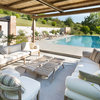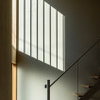how was this color achieved on the walls
debs1
12年前
how was this color achieved on the walls

Mountain Brook renovation · 詳細
注目アンサー
並び替え:古い順
コメント (12)
MCS DESIGNS
11年前I would be surprised if In the Spirit of Decor is correct on this particular photo. This is pecky cypress (it is prized wood found in swamps of SC and GA- the darker bits in this photo are actually pits that are eaten out by bugs) and the technique is called liming, in which powdered lime is mixed into an emulsion and painted on the wood and then excess is wiped off. I do not think that the wood needs to be stained dark beforehand but I could be wrong. Different people have different formulas. This is found often in the Caribbean.MCS DESIGNS
11年前I don't know about using paint colors...the technique I am familiar with is to take powdered lime (fertilizer type) and mix with water until you have a consistency that can be applied with a paint brush like a stain. Then some is wiped off and reapplied in layers.
I imagine if you wanted to do this with paint, you could dilute a white or off-white latex paint with water. typically the wood underneath has been stained a dark color first.
It is a real pain to do this!carrmichael83
11年前In the Spirit of Decor, do you have any photos of the jobs you have done to see if you style accurately reflect what this picture shows?Krantz Select Woods
11年前最終更新:11年前Pecky Cypress is actually caused by a fungus that grows in trees that are 125+ years old. It is found in the Southeast region of the US. You can actually somewhat create this look with a whitewash, from Cabot stains. We carry new growth Pecky Cypress and Pecky Sinker Cypress that is pulled from underwater logging efforts in historic waterways.MCS DESIGNS
11年前bugs or fungus, I am not sure. But the cypress is definitely from the southern area. I have used Cabot stains before- nice products but the original formula wiht this cypress was liming. I recently finished a project where we did not stain the pecky cypress dark but rather left it in its natural state and used a diluted latex stain to create a sort of limed oak finish. quite nice.kelljd2
10年前I am building a home and have a large quantity of pecky cypress that was used as paneling in a 1930s family home that we recently tore down. The cypress has a dark stain (at least from what I have read it the present brownish w hint of orange is not the natural aging color) and I'd like to reuse this gorgeous material and create the exact look in this photo. I've read some comments here - some say it was "limed" and others say this is a "semitransparent paint or glaze"? Does someone know exactly how this was achieved? This look is breathtaking.
Also I'd love any advice for using this in an office - would this work if ceiling is vaulted/white with reclaimed beams and dark chestnut floors? Or should pecky cypress be used on the ceiling with different cabinets or both? thanks to any thoughts.MCS DESIGNS
10年前I have used it in both cabinets and ceilings. Ceiling are easier as the "holes" present challenges in cabinet making. Google or search Houzz for images of ceiling in Palm Beach, Florida and the Caribbean and you can see typical ceilings done this way.
Have a painter check to see what the sealant was used on your original pecky. You may be able to paint with a semi-transparent glaze (made by Ben Moore for outdoors in several shades) or take lime powder and mix with water to get a pancake batter-like consistency and put directly on top of the existing wood. If not, sand well.
If you used lime you will need to apply a flat polyurethane coating to keep the lime from flecking out of the holes.




In the Spirit of Decor